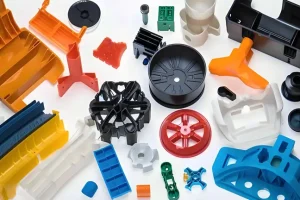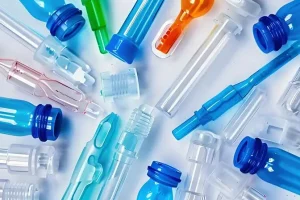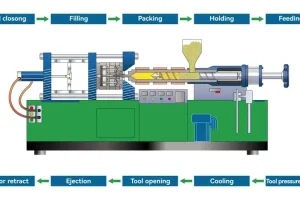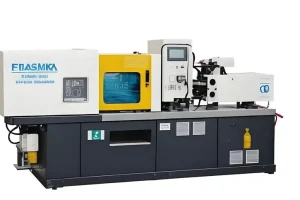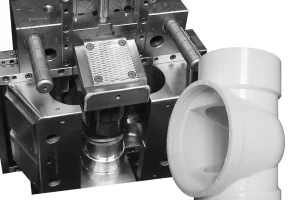Normally speaking, injection molds are made of metal, usually steel, and are precision machined to match the characteristics of the products they are to produce.
However, some products are in low demand and if they are made of steel material, the cost of the mold is too much to invest in. So depending on the number of products, there are injection molds made of silicone material, resin material, aluminum alloy material, and standard steel material.

The selection of mold material is different for different quantity
1. Quantity between 100 and 200
Injection mold for silicone material also called low-pressure injection process or reaction injection molding.

2. Quantity between 200-500
Resin material injection mold, also called low-pressure injection process or reaction injection molding.

3. Quantity between 500-1000
Aluminum molds, which can be injection molded or low-pressure injection process or reaction injection molding.

4. Quantity above 1000
Standard steel material, and standard injection molding process.
Different plastic materials reasonable selection of injection mold steel
Corrosive plastic materials
Many resins and additives have a corrosive effect on the surface of the cavity, this corrosion makes the surface of the cavity metal corrosion, flaking, the surface condition is bad, and the quality of plastic parts deterioration.
For the molding of fluorine, chlorine, and other corrosive plastics such as PVC, POM, and various types of flame retardant plastic molds, if the product requirements are high, you can use imported corrosion-resistant steel, general requirements can be used for domestic corrosion-resistant steel.
Hardened and filled plastic materials
Good wear resistance injection molding plastic surface gloss and precision and injection mold cavity surface wear resistance have a direct relationship, especially some plastics added glass fiber, inorganic fillers, and certain pigments.
They and the plastic melt together in the runner, mold cavity high-speed flow, the cavity surface friction is very large if the material is not wear-resistant, will soon wear, so that the quality of plastic parts by damage.
For molds that have strong friction and impact on steel, such as molds used to inject nylon + glass fiber material, imported or domestic H13 type steel with high wear resistance, high thermal tensile strength, and high toughness should be used.

High-temperature plastic materials
Good dimensional stability in injection molding, injection mold cavity temperature to reach 300 ℃ or more.
For this reason, it is best to use the appropriate tempering treatment tool steel (heat treatment steel). Otherwise, it will cause changes in the microstructure of the material, which will result in changes in the dimensions of the injection mold.
Transparent high-gloss plastic material
Some products need to have good transparency, or high-gloss surface. For molding transparent plastic products mold, the cavity and core are required to use high-grade imported steel with high mirror polishing performance, such as 718 (P20 + Ni class), NAK80 (P21 class), S136 (420 class), H13 class steel, etc., of which 718, NAK80 for the pre-hardened state, no further heat treatment.
S136 and H13 steel are annealed state, hardness is generally HB160-200, after rough machining need to be vacuum quenching and tempering treatment, the hardness of S136 is generally HRC40-50, H13 steel hardness is generally HRC45-55 (can be determined according to the specific grade).

For the product appearance quality requirements, long life, mass production of the mold, the molding parts material selection as follows.
a) cavities need to use high-grade imported steel with high mirror polishing performance, such as 718 (P20 + Ni class), NAK80 (P21 class), etc., are pre-hardened state, no need for heat treatment.
b) The core can use low-grade imported P20 or P20 + Ni steel, such as 618, 738, 2738, 638, 318, etc., are pre-hardened state; for the production of a small number of molds, you can also use domestic plastic mold steel or S50C, S55C and other imported high-quality carbon steel.
For the product appearance quality requirements of the general mold, the molding parts material selection as follows.
a) small, precision mold cavities and cores are used in the mid-range imported P20 or P20 + Ni class steel.
b) medium and large moulds, the molding plastic no special requirements for steel, the cavity can choose low-grade imported P20 or P20 + Ni class steel; core can choose low-grade imported P20 class steel or imported high-quality carbon steel S50C, S55C, etc., can also use domestic plastic mold steel.
c) For the cavity of the etched skin pattern, when the etched pearly pattern should strive to avoid the use of P20 + Ni class 2738 (738) grade.

For no appearance quality requirements of the internal structure of the parts, molding materials on the steel also no special requirements of the mold, the molding parts material selection as follows.
a) For large and medium-sized molds, the cavity can choose low-grade imported P20 or P20 + Ni class steel, can also choose imported high-quality carbon steel S55C, S50C or domestic P20 or P20 + Ni class plastic mold steel; core can choose imported or domestic high-quality carbon steel.
b) For small moulds, if the output is higher and the structure is more complicated, the cavity can choose low-grade imported P20 or P20+Ni type steel, or domestic P20 or P20+Ni type plastic mould steel; the core can choose domestic plastic mould steel.
c) For simple structure and small moulds with low output, the cavities and cores can be made of domestic plastic mould steel or high quality carbon steel.

Plastic mold materials can be divided into the following six categories according to different characteristics
Pre-hardening type
Adding sulfur, calcium, lead, selenium, and other elements to the steel can effectively improve the cutting performance of pre-hardened plastic mold steel.
Pre-hardened plastic mold steel commonly used in China areY55CrNiMnMoV(SM1),5NiSCa,3Cr2Mo,Y20CrNi3AlMnMo(SM2),4Cr5MoSiVS, 8Cr2Mn-WMoVS(8CrMn).
Carburized type
Carburized plastic mold steel has Sweden’s 8416, the United States of P2 and P4, etc..
Domestic often use industrial pure iron (such as DT1 and DT2), 20, 20Cr, 12CrNi3A and 12Cr2Ni4A steel, as well as the latest development of domestic cold forming special steel 0Cr4NiMoV (LJ).
Hardening type
Commonly used hardened plastic mold steel are: carbon tool steel (such as T7A, T8A), low-alloy cold work mold steel (such as 9SiCr, 9Mn2V, CrWMn, GCr15, 7CrSiMnMoV steel), Cr12 type steel (such as Cr12MoV steel), high-speed steel (such as W6Mo5Cr4V2 steel), base steel and some hot work mold steel, etc.
Age-hardening type
Age-hardening plastic mold steel has 18Ni140 grade, 18Ni170 grade and 18Ni210 grade, in addition to 10Ni3MnCuAl(PMS), 18Ni9Co, 06Ni16MoVTiAl, 25CrNi3MoAl, which is characterized by low carbon content and high alloying, and the solid solution formed after high-temperature quenching will be age treated, which can cause strengthening and hardening. It can cause strengthening and hardening of the steel.
Tempering type
Tempered plastic mold steel such as 45, 50, 55, 40Cr, 40Mn, 50Mn, S48C, 4Cr5MoSiV, 38CrMoAlA. steel is precipitation hardening stainless steel with, a hardness of 32 ~ 35HRC that can be machined. The steel then by 460 ~ 480 ℃ aging treatment, can obtain a better overall mechanical property.
Corrosion-resistant
Corrosion-resistant plastic mold steel is mainly 1Cr18Ni9, 2Cr13, 3Cr13, 3Cr17Mo, Cr16Ni4Cu3Nb (PCR), 0Cr17Ni4Cu4Nb (74PH).

Molding parts material selection standards
Molding parts refer to the mold parts that are in direct contact with plastic and molded products, such as cavities, cores, sliders, inserts, slant tops, side draws, etc..
Molding parts material directly related to the quality of the mold, life, determine the appearance of the molded plastic products and internal quality, must be very careful, generally in the contract and customer requirements on the basis of the product and mold requirements and characteristics of the choice.
Forming parts material selection principle is: according to the type of plastic molding, the shape of the product, size and precision, the appearance of the product quality and use requirements, production batch size, taking into account the material cutting, polishing, welding, etching, deformation, wear resistance and other properties.
while taking into account the economy and mold manufacturing conditions and processing methods, to choose different types of steel. Formed inserts are generally used with the same material as the parts into which they are inserted.
For parts of the mold that are difficult to cool or require higher cooling effect, the insert material should be beryllium bronze or alloy aluminum.
For the mold involved in the molding of moving parts material selection principles are as follows.
a) Transparent parts should be selected from high-grade imported steel with good polish, such as 718, NAK80, etc.
b) Non-transparent parts, generally should be selected with high hardness and strength of mid-grade imported steel, such as 618, 738, 2738, 638, 318, etc., surface nitriding treatment, nitriding layer depth of 0.15-0.2mm, hardness of HV700-900.
c) If the mold requirements are low, you can also use low-grade imported steel or domestic steel, nitriding treatment hardness is generally HV600-800.

Non-forming parts material selection
Mold frame material refer to the mold frame standard, the template generally choose imported S50C or domestic SM45, requiring HB160-200, uniform hardness, and small internal stress, not easy to deformation.
The material of guide pillar is GCr15 or SUJ2, hardness is HRC56-62. The material of guide bush, push plate guide pillar, push plate guide bush and reset bar can be GCr15 or SUJ2, hardness is HRC56-62; also can be T8A, T10A, hardness is HRC52-56.
General structural parts in the mold, such as ejector locating ring, column, ejector limit block, limit tie bar, lock module, etc., no special requirements for hardness and wear resistance, can use domestic SM45 steel, normalized state, hardness HB160-200, no further heat treatment.
Mold gate sleeve, wedge block, wear-resistant block, slider platen and other parts with high requirements for hardness, strength and wear resistance, should use carbon tool steel or high-quality carbon tool steel, such as T8A, T10A, etc.. These steels need to be quenched when used to improve their hardness and wear resistance.

Summary
Through the above article introduction, we know that different product quantity should choose different mold materials. And there are many kinds of common standard mold steel, in the actual injection mold manufacturing, we should choose the right mold material according to the characteristics of the plastic product material and the number of products, as well as the structure and size of the products, to get the maximum economic benefits under the premise of ensuring the smooth implementation of the project.


